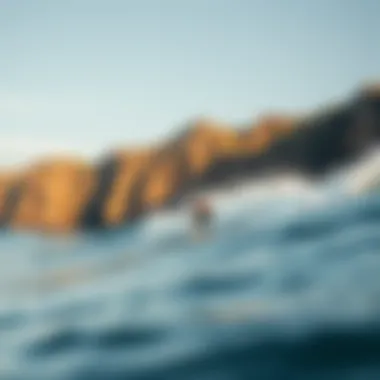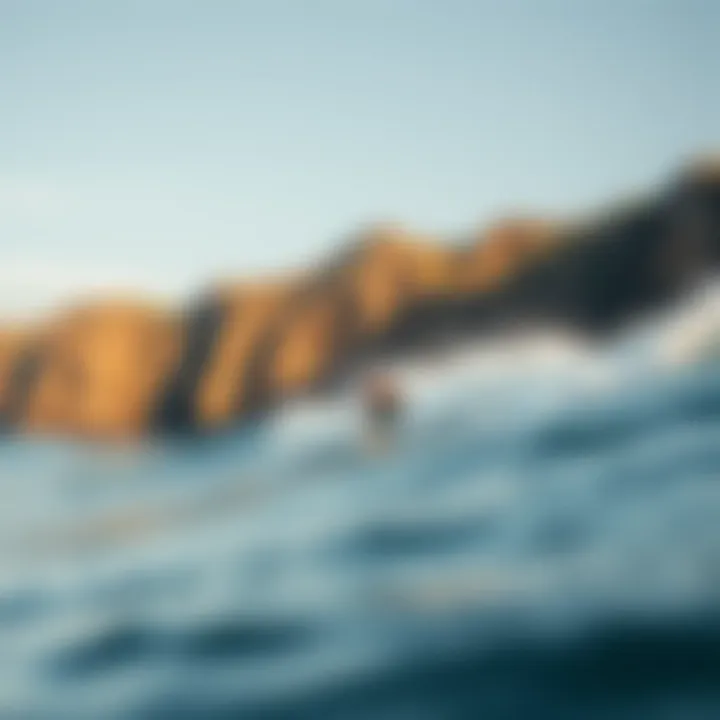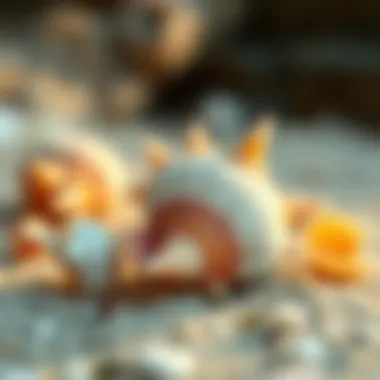The Cultural Impact of Beach Landscapes on Surfing


Intro
Beaches, with their picturesque settings, breathtaking waves, and the scent of salt in the air, furnish a backdrop that transcends mere aesthetics. The allure of the seaside, specifically its interplay with surf culture, weaves together a tapestry of experiences, memories, and techniques that resonate with surfers, travelers, and nature enthusiasts alike. As the sun dances on the ocean's surface, and the rhythmic crash of waves enchants our senses, we begin to scratch the surface of this captivating realm.
Through this article, we will explore various facets of beach scenery, diving deep into how the coastal environment shapes the ethos of surfing. Understanding the delicate balance between nature and sport provides valuable insights into individual experiences and broader cultural implications. Beyond just the rush of catching that perfect wave, this journey skims the surface of sensory experiences, vital environmental elements, and personal narratives that contribute to the vibrant world of surf culture.
What lies beneath the surface? How do the sandy shores and rolling tides influence the techniques and styles adopted by surfers? The following sections will dissect these questions, taking a look at practical tips, board selection, and maintenance – all of which are essential for both novices and seasoned surfers.
Surfing Techniques
Surfing is not merely a sport but a form of expression. From the rush of adrenaline to the peace found in the ocean’s embrace, the techniques honed over countless hours in the water form the backbone of surf culture. Whether you're wiping out or carving sharp turns, every moment contributes to the larger narrative of one's surf journey.
Beginner Tips for Getting Started
For newcomers to the surfing world, the first ride can be both thrilling and daunting. Here are some handy tips:
- Understand the Ocean: Pay close attention to the waves and tides. A solid grasp of ocean dynamics can help you anticipate the best time to paddle out.
- Choose the Right Spot: Not all beaches cater to beginners. Opt for shore breaks with gentle waves instead of gnarly reefs.
- Practice Paddling: Strong paddling skills are crucial for success in catching waves. Spend ample time honing your technique.
- Stay Safe: Always keep safety gear in mind; a good wetsuit and a leash can be lifesavers.
Advanced Maneuvers and Tricks
For those with a few rides under their belt, tackling advanced techniques might be the next step. To master these complex maneuvers, consider:
- Carving: Using your bodyweight effectively allows sharp turns. Lean into your turns for smoother transitions.
- Cutbacks: Engage in these to maintain speed while redirecting yourself on a wave. Timing and balance are key.
- Aerials: Going for aerial tricks adds flair to your repertoire. Start small and gradually work up to more complex flips and spins.
The ocean is ever-changing, and adapting to its whims is part of the thrill.
Surfboard Selection
Selecting the ideal surfboard can profoundly impact your surfing journey. Your choice shapes not only your performance but also your overall connection to the wave.
Choosing the Right Board for Your Style
Every surfer has a unique style that can influence their board choice. Here’s what to consider:
- Board Types: Longboards offer stability and are perfect for beginners, while shortboards allow for tricks and greater speed.
- Volume and Size: Pay heed to your weight and skill level when deciding board volume. A thicker board provides floatation, essential for new surfers.
- Material Matters: Epoxy boards are known for their durability and lightness, making them a favorite for many surfers.
Surfboard Maintenance and Care
Taking care of your board will extend its lifespan and enhance performance:
- Rinse After Use: Always rinse off saltwater and sand. This practice prevents deterioration over time.
- Store Properly: Keep your board in a stable environment, avoiding extreme heat or cold.
- Fix Dings Promptly: Address any damages sooner rather than later. A small crack can lead to bigger problems if ignored.
With proper attention to both your technique and equipment, you'll find greater joy and success out in the waves, deepening your connection to the culture and community surrounding surfing.
"Understanding the ocean is like learning a language. Each wave whispers secrets that only a dedicated listener can comprehend."
As we explore the intersection of cultural identity and artistic expression, we'll uncover how personal stories and the coastal environment shape the experiences of those who revere the sea.
Further Exploration
Consider delving deeper into related subjects at resources like Britannica or join the conversation on community platforms like Reddit. Additionally, check governmental and educational resources through domains such as *.gov and *.edu for insightful information on coastal environments and surfing safety.
Foreword to Beach Scenery
Beach scenery isn't just a backdrop for summer fun; it's a complex tapestry woven from natural beauty, cultural significance, and sensory experiences, each thread contributing to the overall appeal. The sights, sounds, and sensations of the coast resonate deeply with those who seek inspiration from the ocean. By unpacking the various dimensions of beach scenery, this article sheds light on why these landscapes have such a profound effect on surf culture and individual lives alike.
Defining Beach Scenery
When discussing beach scenery, we're not merely referring to a stretch of sand bordered by water; it encompasses everything from the color of the waves to the shape of the shoreline. Beach scenery, in essence, can be divided into various elements:
- Natural Elements: This includes the ocean, sand, and any coastal vegetation like palm trees or shrubs that frame the landscape.
- Weather Conditions: The mood set by clouds, sunlight, or even storms can dramatically alter the perception of a beach.
- Human Impact: The presence of beachgoers, surfboards, and local architecture can also play a significant role.
In essence, beach scenery is an interplay between these factors, creating a unique canvas that shifts with the tides and winds. This fluidity is what many surf enthusiasts find fascinating: the beach is never the same, and neither is the surf.
The Connection Between Scenery and Surf Culture
The link between beach scenery and surf culture is as strong as a rip tide. For surfers, the beach is more than a recreational area; it’s a sacred space that nurtures both the body and spirit. The picturesque coastlines serve as both playground and inspiration.
Surfers often describe the feeling of catching a wave as transcendent—a connection with nature that’s both exhilarating and calming. Here are a few considerations illustrating this relationship:
- Spiritual Connection: Many surfers feel a deep emotional bond to the beach, interpreting it as a place of refuge and contemplation.
- Artistic Inspiration: From intricate surfboard designs to breathtaking photography, beach scenery influences artistic expression in numerous ways.
- Cultural Practices: Surf culture incorporates various elements from environmentalism to community events, all rooted deeply in the ambiance of the beach. For example, surf competitions often take place on stunning backdrops, further intertwining the sport and the scenery.


Sensory Experiences of the Beach
When we talk about beach scenery, we can’t ignore the powerful sensory experiences it offers. These experiences encompass how we see, hear, and feel the beach environment. The beaches are not merely a feast for the eyes; they present a multi-dimensional tapestry that connects us to nature and enriches our lives. Exploring these sensory facets plays a crucial role in understanding how beach landscapes influence surf culture and individual experiences, creating a connection often felt in the heart but hard to articulate.
Visual Aesthetics
Color Palette of the Ocean
The color palette of the ocean is a captivating phenomenon. Ranging from deep navy to azure blue, the ocean's colors can shift dramatically depending on the time of day, weather conditions, and surrounding influences. This spectrum of hues provides a stunning backdrop that draws surfers and beachgoers alike. For instance, a sunrise casts a warm golden light across the water, making even the most chaotic waves seem serene.
This rich color variety not only enhances the scenic view but also evokes emotions. Many artists have tried to capture this interplay of colors. Bright turquoise tones feel energetic, while gradient shades between blues and greens can convey tranquility. It’s this emotional resonance that makes the color palette a beneficial aspect to explore in this article—it deepens not only the appreciation of the beach but also the experience of surfing and relaxation.
However, the dazzling colors can sometimes be misleading. Water pollution, for example, can skew these hues and create drab vistas that are less inviting. Therefore, discussing the color palette also invites consideration of ecological health and vibrant life beneath the surface.
Landscapes and Horizons
Landscapes and horizons at the beach present a captivating relationship between land and sea. The sight of waves gently lapping against the shore, backed by cliffs or palm trees, creates a visual contrast that captivates observers. The horizon—a boundary where the ocean meets the sky—engenders a sense of vastness and possibility. This composition invites the surf culture to thrive within it, as aspiring surfers gaze at the waves, mentally plotting their next ride.
The landscape's uniqueness varies from one shore to another. Some might enjoy the rugged, dramatic cliffs of the Pacific Coast, while others may be drawn to the soft, sandy beaches of the Caribbean. Each setting has its perks. A stimulating landscape can inspire creativity, drawing artists and photographers who want to encapsulate its beauty. Yet, the simplicity of an expansive horizon can also serve a meditative function.
Acknowledging these landscapes showcases their integral role in beach culture, making this aspect vital to the article's narrative. Yet it’s essential to recognize that not all landscapes inspire the same feelings for everyone; individual perceptions are just as varied as the beaches themselves.
Auditory Elements
Waves and their Rhythms
The rhythmic crashing of waves is a soundscape synonymous with the beach experience. Each wave has its unique cadence, morphing from gentle swells to booming crashes, creating a dynamic auditory portrait. The varying sounds can be calming or invigorating depending on one’s mood. Surfers often find themselves tuning into these rhythms, as they can dictate the perfect timing for a successful ride. The sounds of the ocean provide a natural soundtrack ripe with tension and release that mirrors the actions of surfing itself.
Listening closely to the waves fosters a connection between the surfer and the sea, rooting them in the present moment. This sensory experience is beneficial, as it encourages mindfulness, helping surfers to tune out distractions. However, occasionally, the overwhelming roar of waves can overshadow quieter moments, which might be sought after by those seeking solitude.
Wildlife Sounds
The sounds of wildlife add another layer to the auditory experience of the beach. From the distant calls of gulls to the sudden splash of a fish breaking the surface, these natural sounds enrich the atmosphere. The daytime symphony performed by coastal birds creates a lively ambiance, while the haunting calls of seals or the rustling of distant coastal dwellers can invoke a sense of majesty in the environment.
This auditory diversity serves several roles. It enhances the immersive quality of the beach experience, drawing in individuals seeking connection with nature. Additionally, wildlife sounds can influence the behavior of surfers; knowing when to expect fish movements or daring to glimpse dolphins or other aquatic life can transform a standard surfing session into a thrilling adventure. Of course, the ephemeral nature of these sounds means that they may not always be there, so capturing them through art and storytelling remains vital.
Tactile Sensations
Sandy Textures
The texture of sand underfoot is a distinctly unforgettable sensation. The fine grains may sometimes stick to your skin, while at other times, they can feel smooth and warm on a sunny day. This tactile experience serves multiple purposes—not only does it ground surfers before they hit the water, but it also functions as a reminder of the urban borders separating them from the ocean.
Sandy textures serve a crucial role in the overall beach experience. They invite interaction, whether it's laying down for a sunbake or digging a small pit for play. However, not all sand is created equal; some beaches may boast soft, fine grains, while others could leave you wincing as you cut your foot on sharper stones. The diversity in experience invites exploration of different beach environments, allowing slight shifts in texture to greatly impact personal enjoyment.
Water Temperatures
The temperature of the water is another tactile element that profoundly influences the beach experience. Warm waters can encourage long sessions of swimming and surfing, while cooler temperatures might turn the focus to lively engagement on the sand instead. Each temperature shift dictates the approach one must take to enjoy the ocean.
The cool embrace of ocean water on a hot day can be revitalizing, creating a refreshing contrast to the heat of the sun. Conversely, chilly waters may require a wetsuit, altering the surfing experience entirely. By discussing water temperature, we can appreciate how it shapes interactions between enthusiasts and the sea, reinforcing personal routines.
Overall, these sensory experiences deepen our understanding of beach scenery. Each component intertwines with the others, sculpting not just the landscapes and sounds, but also the very culture that surrounds surfing and hammocking by the shoreline. The beach becomes more than just a beautiful place; it transforms into a space where the senses converge, turning experiences into cherished memories.
Ecological Aspects of the Beach Environment
The ecological aspects of beach environments play a crucial role in understanding the intricate relationship they have with surf culture and the overall coastal ecosystem. Beaches aren't just places where sand meets the sea; they serve as biodiverse habitats that support various plant and animal life, and they also reflect the impact of environmental changes. Grasping these aspects can enrich one’s appreciation for these beautiful landscapes and heighten awareness of the responsibilities we hold toward preserving them.
Coastal Ecosystems
Flora and Fauna Diversity
Diving into the diversity of flora and fauna at the beach reveals a vibrant world that often goes unnoticed. Coastal plants, such as sea oats and sand verbena, not only stabilize the dunes but also provide essential cover and food for a variety of wildlife. On the other hand, the intertidal zones teem with life—crabs scuttle about, starfish cling to rocks, and sea urchins find a home among the kelp.
Key characteristic: One key aspect of flora and fauna here is adaptability. Many coastal species have evolved to thrive in salty conditions and sandy soils, showcasing nature’s brilliance. This adaptability benefits coastal ecosystems by maintaining balance, especially regarding nutrient cycling and food webs.
Unique feature: A distinctive feature of these ecosystems is their seasonal fluctuations. Various species bloom or migrate with changing seasons, creating a dynamic tableau that appeals to both photographers and nature lovers alike. However, these fluctuations have their disadvantages. Increased human activity, if unchecked, can threaten these delicate balances, leading to decreased biodiversity.
Sediment and Shoreline Dynamics
The interplay of sediment and shoreline dynamics is another vital element in beach ecology. The movement of sand—driven by wind, waves, and tides—shapes the coastline we enjoy today. This process is fundamental for constructing and maintaining beach habitats.
Key characteristic: Sediment transport contributes to the formation of dunes, which serve as natural barriers against storms and rising sea levels. This makes understanding sediment dynamics crucial, especially for coastal communities focused on sustainability and conservation.


Unique feature: A unique aspect of this phenomenon is the beach’s ability to "reset" itself after extreme weather events. While erosion can be damaging, natural processes often lead to regeneration over time. Yet, heavy human intervention can disrupt this balance, leading to permanent loss of beach areas that surfers and beachgoers cherish.
Impact of Climate Change
Erosion and Its Effects
Erosion is perhaps one of the most discussed impacts of climate changes concerning coastal areas. It occurs when the natural materials of the beach are washed away, altering the landscape and often leading to loss of habitat.
Key characteristic: What sets coastal erosion apart is its gradual yet relentless nature. High tides, stronger storms, and rising sea levels are accelerating this process, directly affecting surfing spots and local ecosystems.
Unique feature: One particularly concerning aspect is the fact that areas suffering from significant erosion may take years, if not decades, to recover. This prolonged damage can strain not just natural habitats but also local economies that rely on tourism.
Changes in Marine Life
The changes in marine life due to climate change are multifaceted. Warmer ocean temperatures can alter fish migration patterns, leading to unexpected shifts in which species are available for catching, while coral bleaching threatens underwater ecosystems and biodiversity.
Key characteristic: A significant aspect is how interconnected these ecosystems are, making disruption in one area ripple through to others. For example, shifts in fish populations can impact local surf conditions, as changes in marine biodiversity may affect water quality and behavior.
Unique feature: Many coastal species are facing heightened vulnerability as their environmental conditions change rapidly. While some may adapt, others might not survive, leading to loss of biodiversity and possibly even the extinction of particular species, leaving surfers to wonder what their favorite spots might look like in the future.
"Every time we step onto the beach, we walk into a world shaped not just by the waves, but by the glimmering connections of life all around us."
Understanding these aspects, therefore, allows us to not only appreciate the beauty of our beaches but also instills a sense of responsibility to protect these delicate ecosystems for future generations. Each wave crashing on the shore tells a story of resilience, adaptation, and the urgent call to act for sustainability in coastal environments. By raising awareness and encouraging eco-friendly practices, we can ensure that the breathtaking scenery continues to inspire and cultivate surf culture.
Cultural Significance of Beach Scenery
The cultural significance of beach scenery weaves a rich tapestry that influences various aspects of human experience, especially in relation to surf culture. In many ways, beaches serve not just as natural wonders, but as cultural landmarks. They become places where stories are made, memories are crafted, and artistic expressions take shape. The dialogue between the ocean and the shores shapes not only the landscape, but also the identity of communities that thrive near these seaside areas.
While the natural beauty of beaches draws millions of visitors each year, it’s the cultural narratives that run deeper. For surfers and beach lovers alike, these locations represent freedom, adventure, and a connection to something greater than themselves. The rhythmic sounds of waves crashing against the shoreline create an ambiance that nourishes creativity, fostering artistic endeavors in various forms.
Artistic Depictions of Beaches
Painting and Photography
Painting and photography have long captured the breathtaking allure of beach landscapes. Artists often utilize these mediums to express their personal encounters with nature, showcasing the vibrant hues of turquoise waters and the muted pastels of stunning sunsets. One key characteristic of these art forms is their versatility; they can be both realistic and abstract, invoking a spectrum of emotions. For the surfers out there, these artworks can evoke a sense of nostalgia or inspire a deeper appreciation for the ocean.
- Contribution: Paintings and photographs allow for an exploration of individual perspectives, allowing each artist to convey their unique relationship with the beach.
- Popular Choice: The visual appeal of beaches makes them a favorite subject, engaging those who might not be surfers but have an affinity for coastal environments.
- Unique Feature: With advancements in technology, digital photography expands potential for capturing stunning details in dynamic light and weather conditions. But, while digital art may allow for creativity, it sometimes lacks the tangible connection that traditional painting can provide.
Literary Contributions
Literature has often encapsulated the essence of the beach, weaving narratives that reflect the beauty, struggle, and transformation that come with coastal life. From poets to novelists, writers explore themes of solitude, adventure, and community through their literary eyes. An important characteristic is the way literature can transport readers to the beach, creating an immersive experience with descriptive language that evokes sensory memories.
- Contribution: Literary works about beaches can foster connection, encouraging readers to reflect on their own experiences with the sea.
- Popular Choice: Many authors find inspiration from their personal encounters at the beach and express feelings that resonate universally.
- Unique Feature: The written word allows for deep exploration of emotion and introspection, offering a different kind of engagement compared to visual arts. However, it can sometimes be abstract, leading to misinterpretations of the authors’ intentions.
Aesthetic Influences on Surf Culture
Surfboard Artistry
Surfboard artistry is a fascinating blend of functionality and aesthetics, reflecting both the sport and the culture surrounding it. Each board is often a blank canvas, where shapers and artists collaborate to create pieces that embody local influences, individual style, and deeper cultural meanings. One notable characteristic is the personalization of surfboards through vibrant artwork that speaks to an individual's identity as a surfer.
- Contribution: Artistic surfboards build a sense of community and culture around surfing, and they serve as conversation starters both in and out of the water.
- Popular Choice: The colorful and unique designs can attract surfers who wish to express themselves creatively, attracting attention and resonating with others on the waves.
- Unique Feature: The thriving market for custom surfboard art helps small artists while increasing the visibility of local culture on a global stage. However, the demand for design may sometimes overshadow the fundamental purpose of the board.
Fashion Inspired by Coastal Settings
Fashion influenced by beach aesthetics characterizes an entire lifestyle movement, heavily imbued with comfort and a laid-back vibe. From swimwear to everyday attire, the designs often draw upon elements like ocean hues, surf motifs, and even marine life. A key characteristic of this fashion segment is its natural versatility, appealing to both active beachgoers and those who enjoy a casual style in everyday life.
- Contribution: Coastal inspired fashion enhances community connections, influencing social gatherings and friendships that often form around a shared love for the ocean and surf culture.
- Popular Choice: The styles resonate with a large audience, making them trendy and commercially successful, while helping brands connect with their customer base.
- Unique Feature: While the global fashion industry may promote diversity in styles, it can sometimes lead to a disconnect with the authentic beach culture that inspired those styles, losing some cultural significance along the way.
"The beaches aren't just places to surf; they're the canvases upon which different cultures paint their identities and histories."
In short, the cultural significance of beach scenery — reflected in artistic depictions and aesthetic influences on surf culture — ultimately unites individuals through shared experiences and expressions. Understanding these dimensions offers the chance to enrich one's own encounters at the beach, helping to preserve the true spirit of coastal life.
Personal Narratives and Experiences
When one speaks of beaches, it’s often the waves and the sand that first come to mind. However, it’s the personal stories interwoven with these coastal experiences that breathe life into beach culture. Personal narratives matter because they reveal how individuals connect with the beach, the surf, and each other. Each tale carries with it unique insights, emotions, and lessons that underscore the deeper significance of this picturesque environment. Surfing isn’t just a sport; it’s a way of life for many—a reflection of identity, belonging, and even transformation.
Stories from Surfers
Memorable Sessions
Memorable surfing sessions often resonate deeply with surfers, transcending the simple act of riding waves. Imagine a morning when the sun is just starting to peek through the horizon, golden rays dancing on the water’s surface. That moment is etched in memory, not just for the thrill of the ride but for the entirety of the experience—the laughter of friends, the salty breeze, and the collective anticipation shared among surfers waiting for the next big wave.


This connection characterizes memorable sessions as they are more than just time spent on a board but moments of pure bliss and fellowship. The camaraderie formed during such sessions can shape social bonds, creating a community that thrives on shared experiences. Yet, while there’s joy in these stories, there can be challenges too. The risk of injury or the strain of competition sometimes casts a shadow. These elements add depth and a sense of realism, reminding us that while the waves can be exhilarating, they also call for respect and caution.
Transformative Encounters with Nature
Transformative encounters with nature often emerge during surfing, offering layers of significance beyond just the physical engagement with waves. Surfers frequently describe a sense of oneness—an almost spiritual experience when they become attuned to the rhythm of the ocean. This connection can lead to profound personal growth, prompting introspection and even life changes.
Such encounters illustrate how nature serves as a teacher. Surfers emerge from the ocean not just exhilarated, but often reflecting on their place within the larger tapestry of life. For instance, a surfer who conquers their fears may find a newfound confidence, using that momentum to tackle challenges beyond the water. However, these experiences can also reveal the fragility of nature, provoking a sense of urgency to protect coastal ecosystems. This duality—the thrill of riding waves combined with an awareness of environmental responsibility—propels storytelling in surfing culture, making it rich and resonant.
Beach as a Place of Reflection
Meditative Qualities
The beach, with its rhythmic sounds and vast horizons, serves as a powerful space for reflection. Many visitors discover its meditative qualities during their time along the shore. The sound of waves crashing can soothe the mind, creating a calming backdrop that promotes deep thinking and personal insight. It's no wonder that people flock to the beach for solitude, away from the chaos of daily life.
This quality is crucial because it invites introspection, allowing individuals to confront their thoughts and emotions in a calming environment. The unique feature here is the duality of relaxation and contemplation. While it’s a space for leisure, it also encourages a profound connection with one’s self. However, the solitude that comes with such moments can evoke feelings of loneliness for some. Understanding this dynamic adds layers to why the beach is so much more than a scenic getaway.
Connection to Community
The beach establishes a deep connection to community, becoming a gathering point not just for surfers but for families, friends, and various social groups. This shared space fosters relationships, creating opportunities for dialogue, collaboration, and support. For many, the beach is where childhood memories are built, creating a legacy passed down from generation to generation.
The allure of this connection lies in its ability to unite diverse groups of people. Common interests in surfing or simply enjoying the sun can break down barriers, bringing people together in celebration of nature. However, as more seek out these spaces, challenges like overcrowding and environmental impact can emerge. This raises questions about sustainability and the responsibility of communities to protect their coastal treasures. Argumentation often surfaces in conversations about preserving the essence of beach culture alongside its increasing popularity.
Future of Beach Landscapes and Surf Culture
The future of beach landscapes and surf culture holds significant importance as we continue to witness changes in environmental conditions and societal values. As the entrenched connection between surfers and their coastal paradises becomes more vital, understanding how to safeguard these locations is key for sustaining surf culture. It emphasizes not just the beauty of the beaches but also the culture that flourishes around them. This section highlights sustainable practices and technological innovations that shape our surfing environment.
Sustainable Practices
Conservation Efforts
Conservation efforts play a pivotal role in preserving beach ecosystems. They encompass actions aimed at protecting natural resources, ensuring the health of marine life, and maintaining the aesthetic appeal of summer getaways. One key characteristic of these efforts is that they engage local communities, surf schools, and environmental organizations. By promoting awareness and educational opportunities, conservation initiatives can foster bonds among surfers, ecologists, and the general public. It's a beneficial choice because it not only protects the coastal beauty but stitches a stronger community fabric.
One unique feature of conservation efforts is the beach clean-up campaigns. These gatherings not only beautify the shorelines but also serve as a rite of passage for new surfers, connecting them to local surf culture. The advantages here are myriad: cleaner beaches enhance the overall experience for surfers, bolster marine ecosystems, and offer a great avenues for personal health when participants embrace physical activity. Conversely, the downside can be the temporary nature of the clean-up; without ongoing commitments, the benefits can quickly diminish.
Promoting Eco-Friendly Surfing
Promoting eco-friendly surfing goes hand in hand with these conservation efforts. This aspect emphasizes the adoption of sustainable practices among surfers to reduce their environmental impact. The key characteristic here involves utilizing equipment and resources that minimize harm to nature, such as sustainable surfboards made from eco-friendly materials. This choice is popular among environmentally conscious surfers, reflecting a growing trend towards taking responsibility for ocean health.
A unique feature of this movement is the emergence of companies like Firewire and Sustainable Surf, which create boards that are not only high performance but also environmentally responsible. The advantages of this approach include fostering a culture of responsibility among surfers while also enhancing the market for sustainable products. However, the cost of such eco-friendly options can be a disadvantage, making them less accessible to all surfers.
Technological Innovations
Surfboard Technology
Innovations in surfboard technology are another vital aspect that outlines the future of surf culture. This advancement has introduced multi-functional boards that adapt to changing wave conditions. A key characteristic is that modern boards are often crafted from lighter and more durable materials, thus enhancing performance without sacrificing sustainability. These innovative boards contribute to the overall goal of improving the surfing experience while being mindful of ecological footprints.
For instance, boards with innovative designs such as the use of recycled or bio-based materials not only provide superior performance but also reduce waste, aligning with growing environmental consciousness in surf culture. The advantage here is clear: better performance equates to a more enjoyable ride. Yet, the disadvantage could be a higher price point compared to traditional boards, which may limit their accessibility to novice surfers or those on a budget.
Virtual Reality and Surfing
The realm of virtual reality and surfing is an intriguing area showing promise for the future. Applications that simulate surfing experiences allow enthusiasts to practice without being in the ocean. This innovation appeals to both seasoned surfers and trainees looking to fine-tune their skills. It highlights inclusivity in surf culture, as anyone can access these experiences from their living rooms.
A unique feature of virtual reality in surfing education is its capability to visualize concepts that may be challenging to understand in real life, such as wave dynamics and board control. This opens doors for enhanced learning and better preparation for real-world surfing challenges. However, relying solely on virtual experiences may disconnect some surfers from the wholesome essence of actually connecting with nature, missing out on the physical and mental benefits provided by the ocean.
As we stand on this precipice of evolution, the choices made today regarding sustainable practices and technological discoveries will echo throughout the future of beach landscapes and surf culture, potentially altering both lifestyles and environments for generations to come.
In summary, the future of beach landscapes and surf culture hinges on the balance between enjoying these experiences and respecting the ecosystems that host them. By being proactive in conservation and leveraging technological advancements, surfers not only secure their present but ensure a vibrant future for beach surroundings.
The End
In wrapping up our exploration of beach scenery and its influential role in surf culture, it’s vital to recognize its multifaceted nature. The nuances of coastal landscapes go beyond mere visuals— they intertwine with personal experiences and ecological factors that shape life in and around the water. From the rustle of palm fronds to the endless horizons of the ocean, each element contributes to a powerful tapestry that surfers, travelers, and nature enthusiasts alike hold dear.
Recap of Beach Scenery's Importance
Beach scenery is more than just a backdrop for surfing; it encapsulates a dynamic relationship that intertwines aesthetics, ecology, and personal reflection. The variety of colors found in the ocean reflect moods that can shift with the tides, while the textures underfoot—be it fine grains of sand or rocky outcrops—provide tactile experiences that ground individuals in the moment.
- Visual Impact: Lush landscapes and vivid sunsets can inspire artists, while surfers find motivation before paddling out.
- Ecological Awareness: Understanding the environment enhances respect for nature, prompting conservation efforts.
- Cultural Connections: The beach serves as a nucleus for community gatherings, storytelling, and shared experiences that fortify bonds among individuals.
The importance of beach scenery lingers beyond its beauty; it invites exploration of deeper connections to our surroundings, fostering a dialogue that encourages responsible enjoyment of coastal ecosystems.
Call to Action
As we reflect on the beauty and significance of beach scenery, the call to action becomes crystal clear: Protect and cherish these natural wonders. Here’s how individuals can contribute:
- Participate in Clean-Up Events: Join local initiatives aimed at preserving beach landscapes.
- Support Eco-Friendly Brands: Choose gear and products that promote sustainability within surf culture.
- Advocate for Policies: Engage with community governance to ensure the protection of coastal ecosystems from development and pollution.
Embracing these actions is not just about preserving physical beauty; it is about keeping the spirit of surfing— and the connection to nature— alive for future generations. As you ponder your next beach outing, remember: the scenery is a living entity, deserving both respect and responsibility. Together, we can ensure that the allure of the coast remains intact, providing lasting enjoyment and inspiration.
"The beach is not a place, but a feeling that connects us to the larger world around us."



